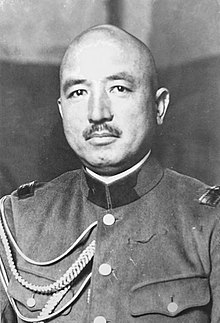Renya Mutaguchi | |
|---|---|
 Lieutenant General Renya Mutaguchi | |
| Born | 7 October 1888 Saga prefecture, Empire of Japan |
| Died | 2 August 1966 (aged 77) Chōfu, Tokyo, Japan |
| Allegiance | |
| Service/ | |
| Years of service | 1910–1945 |
| Rank | Lieutenant General |
| Commands held | IJA 18th Division, IJA 15th Army |
| Battles/wars |
Siberian Intervention Second Sino-Japanese War World War II Battle of Pasir Panjang |
Renya Mutaguchi (牟田口 廉也, Mutaguchi Ren'ya, 7 October 1888 – 2 August 1966) was a Japanese military officer, lieutenant general in the Imperial Japanese Army during World War II and field commander of the IJA forces during the Battle of Imphal.
Biography
Mutaguchi was a native of Saga Prefecture. He graduated from the 22nd class of the Imperial Japanese Army Academy in 1910 and from the 29th class of the Army Staff College in 1917.
Mutaguchi served in the Japanese forces with the Siberian Intervention against the Bolshevik Red Army in the Russian Far East. Afterwards, he was sent as a military attaché to France. [1]
Promoted to major in 1926 and colonel in 1930, from 1933–1936 he served in the General Affairs Section of the Imperial Japanese Army General Staff in Tokyo, before being transferred to China in 1936 to take command of the Japanese garrison force in Beijing. He was commander of the IJA 1st Infantry Regiment in China from 1936–1938. Units responsible to Mutaguchi were involved in the Marco Polo Bridge Incident of 7 July 1937, which helped launch the Second Sino-Japanese War.
Mutaguchi was promoted to major general in 1938, and served as Chief of Staff of the Fourth Army from 1938–1939. He was then recalled to Japan and served from 1939–1941 as Commandant of the Military Preparatory School. [2]
Promoted to lieutenant general in 1940, with the start of the Pacific War, Mutaguchi was given command of the 18th Division in April 1941. This division was active in the invasion of Malaya in the early stages of the war, and Mutaguchi himself was wounded during the Battle of Singapore in February 1942. After the fall of Singapore, the 18th Division was transferred to the Philippines to reinforce units pushing the remaining American forces down the Bataan Peninsula. In April 1942, the 18th Division was reassigned to Burma.
Mutaguchi was then made commander of the Fifteenth Army from March 1943, and strongly pushed forward his own plan to advance into Assam, leading to the Battle of Imphal. After the failure of the Imphal offensive in May 1944, Mutaguchi refused to allow his divisional commanders to retreat, and instead dismissed all three of them. He eventually called off the attack on 3 July. Some 55,000 of Mutaguchi's 85,000-man force ended up as casualties, many dying from starvation or disease. This was the worst defeat suffered by the Japanese army at that time. With the complete collapse of the offensive, Mutaguchi was relieved of command on 30 August and recalled to Tokyo. He was forced into retirement in December 1944. [3]
Mutaguchi was recalled briefly to active service in 1945, to resume his former post as Commandant of the Military Preparatory School.
After the end of the war, he was arrested by the American occupation authorities and extradited to Singapore, where he faced a military tribunal which convicted him of war crimes. Released from prison in March 1948, he returned to Japan. Mutaguchi died in Tokyo on 2 August 1966. [4]
Reputation
British historian Frank McLynn characterized Mutaguchi as "eccentric," "reckless," and a "fanatic," citing his decision to provide his soldiers with only twenty days of food for the nearly four month-long Battle of Imphal. [5] This led to catastrophic loss of life for the Imperial Japanese Army prior to the battle, losing 55,000 out of his 90,000 men to starvation. In the end only 12,000 of his soldiers returned to Japan alive, a staggering 87% casualty rate.
The novelist Takagi Toshirō claimed that after the war Mutaguchi distributed pamphlets at veterans' funerals claiming that he won the battle. Takagi provided no evidence for this, and in 2022, a military historian called it a fabrication. [6]
Popular culture
- Portrayed by Kim Ki-joo in the 1991-1992 MBC TV series Eyes of Dawn.
- Portrayed by T. S. Jeffrey in the 2015 Malaysian film Kapsul.
References
Books
- Fuller, Richard (1992). Shokan: Hirohito's Samurai. London: Arms and Armor. ISBN 1-85409-151-4.
- Hayashi, Saburo; Cox, Alvin D (1959). Kogun: The Japanese Army in the Pacific War. Quantico, VA: The Marine Corps Association.
- Louis, Allen (1984). Burma: The longest War. Dent Publishing. ISBN 0-460-02474-4.
- Hsu, Long-hsuen; Chang Ming-kai (1971). History of The Sino-Japanese War (1937-1945) 2nd Ed. Taiwan Republic of China: Chung Wu Publishing.
External links
- Ammenthorp, Steen. "Lieutenant-General Renya Mutaguchi". The Generals of World War II.
- Budge, Kent. "Mutaguchi, Renya". Pacific War Online Encyclopedia.
- Rothwell, Steve. "Order of Battle of the Japanese 15th Army, January 1942". British & Commonwealth Orders of Battle Website.
Notes
- ^ Budge, The Pacific War ONline Encyclopedia
- ^ Ammenthorp, The Generals of World War II
- ^ Louis, Burma-The Longest War
- ^ "RENYA MUTAGUCHI, JAPANESE GENERAL". The New York Times. 1966-08-04. ISSN 0362-4331. Retrieved 2022-01-22.
- ^ McLynn, Frank (2011). The Burma campaign : disaster into triumph, 1942-45. New Haven, CT: Yale University Press. ISBN 978-0-300-17836-4. OCLC 758389529.
- ^ 関口高史『牟田口廉也とインパール作戦:日本陸軍「無責任の総和」を問う』(DMMブックス版)光文社〈光文社新書〉、2022. ISBN 978-4334046163